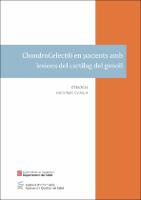| dc.contributor | Departament de Salut |
| dc.contributor.author | Comitè d’Avaluació de Medicaments d’Ús Hospitalari (CAMUH) |
| dc.date.accessioned | 2017-08-30T11:04:44Z |
| dc.date.available | 2017-08-30T11:04:44Z |
| dc.date.issued | 2011-09 |
| dc.identifier.citation | Comitè d’Avaluació de Medicaments d’Ús Hospitalari (CAMUH). ChondroCelect® en pacients amb lesions del cartílag del genoll. Barcelona: Agència d’Informació, Avaluació i Qualitat en Salut; 2011. |
| dc.identifier.other | CT18/2011 |
| dc.identifier.uri | https://hdl.handle.net/11351/3039 |
| dc.description | Lesions del cartílag del genoll; Tractament |
| dc.description.abstract | Antecedents: ChondroCelect® és un producte medicinal derivat del propi cartílag dels pacients. Es trasplanta seguint el procés de trasplantament de condròcits autòlegs (TCA), una tècnica
dissenyada per regenerar cartílag articular. A diferència d’altres mètodes de TCA, ChondroCelect® es basa en la utilització d’una població ben caracteritzada i potent de cèl·lules.
És el primer producte de teràpia avançada aprovat per l’Agència Europea del Medicament
(octubre de 2009).
Objectius: Analitzar l’evidència científica disponible sobre l’eficàcia, la seguretat i l’eficiència de
ChondroCelect® en pacients adults amb lesions úniques del còndil femoral del genoll.
Metodologia: Revisió sistemàtica de l’evidència científica disponible fins al desembre de 2010.
Resultats: Les dades principals d’eficàcia del ChondroCelect® provenen d’un assaig clínic aleatoritzat de fase III i risc elevat de biaix que compara ChondroCelect® (n=57) amb microfractura (n=61) en pacients adults amb lesions úniques del cartílag dels còndils femorals del genoll (1-5 cm2, graus III-IV de la International Cartilage Repair Society) als dotze i trenta-sis
mesos. D’acord amb aquestes dades, Chondrocelect® és superior a la microfractura en les
variables de reparació estructural, tant la histomorfomètrica com la histològica, als dotze mesos de la intervenció alhora que és comparable a la microfractura en la vessant més clínica, mesurada amb la puntuació KOOS (Knee Injury and Osteoarthritis Outcome Score).
Tot i que la millora de la puntuació global KOOS va ser significativa als trenta-sis mesos, la diferència entre grups no es considera rellevant clínicament. La implantació de Chondrocelect® és generalment ben tolerada.
Els esdeveniments adversos més freqüents van ser l’artràlgia, la hipertròfia simptomàtica del
cartílag, la crepitació articular, la inflamació del genoll i el vessament articular. La freqüència
d’esdeveniments adversos va ser similar a la dels pacients sotmesos a microfractura.
Conclusions: Chondrocelect® és superior a la microfractura a curt termini en termes de reparació
estructural d’acord amb els resultats d’un assaig clínic aleatoritzat de fase III. A llarg termini, és superior també en variables clíniques però les diferències no es consideren rellevants. |
| dc.language.iso | cat |
| dc.publisher | Agència d’Informació, Avaluació i Qualitat en Salut |
| dc.rights | Atribución-NoComercial-SinDerivadas 3.0 España |
| dc.rights.uri | http://creativecommons.org/licenses/by-nc-nd/3.0/es/ |
| dc.source | Scientia |
| dc.subject | Genolls - Cirurgia |
| dc.subject | Cartílags articulars - Ferides i lesions |
| dc.subject.mesh | Cartilage, Articular |
| dc.subject.mesh | /injuries |
| dc.subject.mesh | /surgery |
| dc.title | ChondroCelect® en pacients amb lesions del cartílag del genoll |
| dc.type | info:eu-repo/semantics/report |
| dc.identifier.dl | B. 34920-2011 |
| dc.subject.decs | cartílago auricular |
| dc.subject.decs | /lesiones |
| dc.subject.decs | /cirugía |
| dc.type.version | info:eu-repo/semantics/publishedVersion |
| dc.audience | Professionals |
| dc.rights.accessrights | info:eu-repo/semantics/openAccess |

